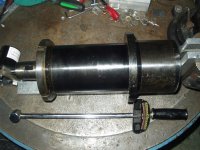magno_grail
Hot Rolled
- Joined
- May 29, 2014
- Location
- ca, US
I decided to look into the two problems that I have had since getting this machine running, spindle noise and poor finish on profiling cuts. I had put a rod down the transmission breather hole on top and it only came back wet on the very end. Lifetime lubrication - when it runs out of lube it runs out of life. I added some 80W gear oil and ATF to see if it made a difference. Not noticable.
I pulled the drawbar piston assembly (which is much different than the pictures in the manual - rectagular piston with rounded corners) and pulled the transmission forward to get the drive belt off. I ran the motor and the transmission was fairly quiet, no where near the noise it had before so I think almost all the noise must be from the spindle. The poor finish from side loaded tools would agree. I dropped the spindle out. The first task was taking the bearing nut off the top bearing. I bought an automotive axle nut wrench then made a driver block to weld on to it. I presumed the nut was torqued so I first tried a torque wrench so I could measure it. I was beyond the 150 ft-lb of the wrench. It took my 18" long 3/4" drive breaker bar with me standing on the end to loosen the nut. I have a steel tube that I use for pressing crankshafts and it came in handy to support the spindle housing whilst pressing the spindle out.
The spindle has two more bearing nuts locking the lower two bearings on the shaft. Now I am trying to decide whether to spend $50 on a hook spanner or make another.




I pulled the drawbar piston assembly (which is much different than the pictures in the manual - rectagular piston with rounded corners) and pulled the transmission forward to get the drive belt off. I ran the motor and the transmission was fairly quiet, no where near the noise it had before so I think almost all the noise must be from the spindle. The poor finish from side loaded tools would agree. I dropped the spindle out. The first task was taking the bearing nut off the top bearing. I bought an automotive axle nut wrench then made a driver block to weld on to it. I presumed the nut was torqued so I first tried a torque wrench so I could measure it. I was beyond the 150 ft-lb of the wrench. It took my 18" long 3/4" drive breaker bar with me standing on the end to loosen the nut. I have a steel tube that I use for pressing crankshafts and it came in handy to support the spindle housing whilst pressing the spindle out.
The spindle has two more bearing nuts locking the lower two bearings on the shaft. Now I am trying to decide whether to spend $50 on a hook spanner or make another.







